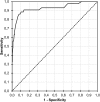Food cravings in food addiction: exploring a potential cut-off value of the Food Cravings Questionnaire-Trait-reduced
- PMID: 29080949
- PMCID: PMC5807499
- DOI: 10.1007/s40519-017-0452-3
Food cravings in food addiction: exploring a potential cut-off value of the Food Cravings Questionnaire-Trait-reduced
Abstract
Purpose: The Food Cravings Questionnaires are among the most often used measures for assessing the frequency and intensity of food craving experiences. However, there is a lack of studies that have examined specific cut-off scores that may indicate pathologically elevated levels of food cravings.
Methods: Receiver-Operating-Characteristic analysis was used to determine sensitivity and specificity of scores on the Food Cravings Questionnaire-Trait-reduced (FCQ-T-r) for discriminating between individuals with (n = 43) and without (n = 389) "food addiction" as assessed with the Yale Food Addiction Scale 2.0.
Results: A cut-off score of 50 on the FCQ-T-r discriminated between individuals with and without "food addiction" with high sensitivity (85%) and specificity (93%).
Conclusions: FCQ-T-r scores of 50 and higher may indicate clinically relevant levels of trait food craving.
Level of evidence: Level V, descriptive study.
Keywords: Food Cravings Questionnaire-Trait; Food addiction; Food craving; Yale Food Addiction Scale.
Conflict of interest statement
Conflict of interest
The author declares that he has no conflict of interest.
Ethical approval
All procedures performed in studies involving human participants were in accordance with the ethical standards of the institutional and/or national research committee and with the 1964 Helsinki declaration and its later amendments or comparable ethical standards.
Informed consent
Informed consent was obtained from all individual participants included in the study.
Figures


Similar articles
-
Chocolate versions of the Food Cravings Questionnaires. Associations with chocolate exposure-induced salivary flow and ad libitum chocolate consumption.Appetite. 2015 Aug;91:256-65. doi: 10.1016/j.appet.2015.04.054. Epub 2015 Apr 23. Appetite. 2015. PMID: 25913686
-
Psychometric properties of the English Food Cravings Questionnaire-Trait-reduced (FCQ-T-r).Eat Behav. 2016 Jan;20:34-8. doi: 10.1016/j.eatbeh.2015.11.011. Epub 2015 Nov 12. Eat Behav. 2016. PMID: 26609669
-
Food cravings in everyday life: An EMA study on snack-related thoughts, cravings, and consumption.Appetite. 2017 Jun 1;113:215-223. doi: 10.1016/j.appet.2017.02.037. Epub 2017 Feb 27. Appetite. 2017. PMID: 28249745
-
Food cravings and body weight: a conditioning response.Curr Opin Endocrinol Diabetes Obes. 2018 Oct;25(5):298-302. doi: 10.1097/MED.0000000000000434. Curr Opin Endocrinol Diabetes Obes. 2018. PMID: 30048258 Free PMC article. Review.
-
A narrative review of reward sensitivity, rash impulsivity, and food addiction in adolescents.Prog Neuropsychopharmacol Biol Psychiatry. 2021 Jul 13;109:110265. doi: 10.1016/j.pnpbp.2021.110265. Epub 2021 Feb 3. Prog Neuropsychopharmacol Biol Psychiatry. 2021. PMID: 33545225 Review.
Cited by
-
Persian Version of the Yale Food Addiction Scale 2.0: Psychometric Analysis and Setting Cutoff Point for the Food Cravings Questionnaire-Trait-Reduced.Psychiatry Investig. 2021 Mar;18(3):179-186. doi: 10.30773/pi.2020.0198. Epub 2021 Mar 19. Psychiatry Investig. 2021. PMID: 33735551 Free PMC article.
-
Correlates of interpersonal emotion regulation problems in Loss of Control eating (LOC) in youth: study protocol of the combined online and App based questionnaire, laboratory and randomized controlled online intervention i-BEAT trial.BMC Psychol. 2021 Dec 11;9(1):193. doi: 10.1186/s40359-021-00690-8. BMC Psychol. 2021. PMID: 34895337 Free PMC article.
-
Clustering individuals' temporal patterns of affective states, hunger, and food craving by latent class vector-autoregression.Int J Behav Nutr Phys Act. 2022 May 21;19(1):57. doi: 10.1186/s12966-022-01293-1. Int J Behav Nutr Phys Act. 2022. PMID: 35597952 Free PMC article.
-
Food addiction and its relationship with disordered eating behaviours and obesity.Eat Weight Disord. 2019 Dec;24(6):1031-1039. doi: 10.1007/s40519-019-00662-3. Epub 2019 Mar 8. Eat Weight Disord. 2019. PMID: 30850958
-
Questioning the validity of food addiction: a critical review.Front Behav Neurosci. 2025 Jul 30;19:1562185. doi: 10.3389/fnbeh.2025.1562185. eCollection 2025. Front Behav Neurosci. 2025. PMID: 40810032 Free PMC article. Review.
References
MeSH terms
LinkOut - more resources
Full Text Sources
Other Literature Sources
Research Materials

